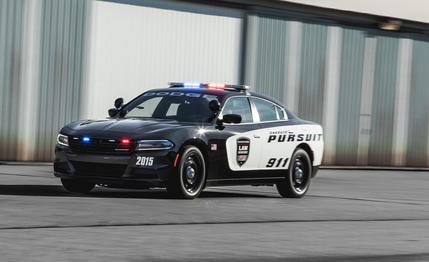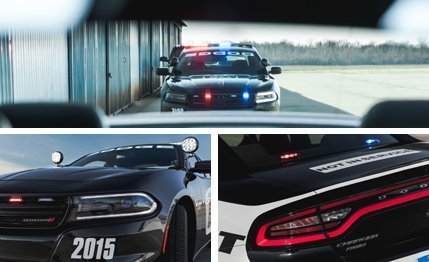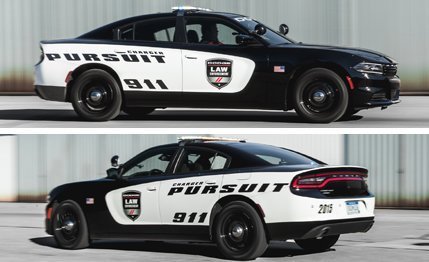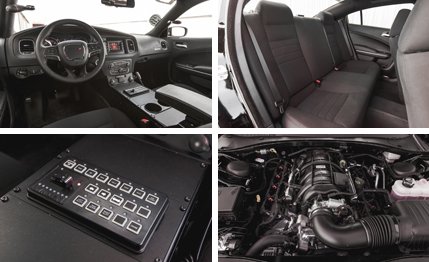 Instrumented Test
Instrumented Test
Driving a Dodge Charger Pursuit demonstrator painted to resemble a real police car, complete with operating lights and sirens, can be a strange experience, as we noted the last time we did this with a 2012 model. People—other drivers—assume things when they see it simply going down the road or when you stop for coffee or get gas.
One editor told us to “have fun” with the car. Another warned that, “It’s a felony to impersonate a police officer.” And a third just said, “Be careful . . . not everyone likes cops.”

Any tension we might have felt was broken the next morning, when a woman fed us the straight line as we walked from the parking lot into a breakfast joint. “Are you police?” she asked. And we got to say, Elwood Blues–style, “No ma’am. We’re musicians.”
Unlike the iconic Bluesmobile, this big Dodge was equipped with a Hemi V-8 coupled to all-wheel drive, a combination no longer offered in the civilian Charger, mostly because few buyers wanted to pay the freight for both pricey options. (This combination has been dropped from the Chrysler 300, as well.)
All-wheel drive, though, enjoys rising popularity among police departments. Police: The Law Enforcement Magazine reports that this is one of those unintended consequences of change. It says that when Ford stopped making the most popular police cruiser/interceptor, the rear-drive Crown Victoria, the company offered fleet buyers their choice of either front- or all-wheel drive for its Taurus-based Police Interceptor sedan and Explorer-based P.I. Utility. When 97 percent of sales went all-wheel drive, Ford made that the standard setup. Now, Chevrolet with its Tahoe PPV (formerly rear-drive only) and Dodge with its Charger see expanding interest in all-wheel drive.

Having four driven wheels, police are finding, puts the power down more effectively and makes it easier to handle a car safely at speed. Fuel economy is not as good and maintenance costs can be higher, but automakers are pitching the safety, security, and all-weather ability—and fleets are buying.
In our tests, this Hemi/AWD Charger ran to 60 mph in 5.2 seconds on the way to a 13.8-second quarter-mile at 103 mph. Not Hellcat stuff, nor even SRT 392, but virtually identical to the rear-drive model in that 2012 test (5.2, 13.9 at 103). Like the civilian Charger, the versions offered to fleet buyers got restyled and received hardware upgrades for 2015—but not the eight-speed transmission. The cop model still has the five-speed automatic, designated as “autostick” by Dodge even though the lever is column-mounted (to leave room for computer and radio hardware between the seats) with a toggle to shift gears. If you’re thinking you could outrun this car, we have two words for you: “radio” and “helicopter.”
Charger Pursuit cars get a heavy-duty suspension with rear load-leveling, performance-tuned electrohydraulic power steering with a fluid cooler, a 220-amp alternator and 800-amp battery, heavy-duty disc brakes with police-tuned ABS, and severe-duty engine cooling—you know, that whole “cop motor, cop tires, cop suspension” thing. The steering feels solid, as do the brakes, like serious hardware. At the track, we stopped from 70 mph in 174 feet and circled the skidpad at 0.85 g on Goodyear Eagle RS-A all-season tires, size 225/60R-18. Not impressive numbers unless you take into account the Charger’s 4579-pound curb weight and its relatively comfortable ride.

The base sticker on a Hemi/AWD edition is $36,795; our test car had various options lifting it to $40,875. The biggest chunk was $2000 for the Base Prep Police package. That’s the wiring and support for lights, sirens, and speakers. Our car also had power seats, adjustable pedals, a backup camera, and the (standard) UConnect interface. Yeah, it was easy to connect our phone via Bluetooth. But there’s no navigation on the five-inch touch screen, because the police are going to install a laptop on the console between the two front buckets anyway. It’d be easy to make fat-cop/donut jokes about those wide, flat seats, but they’re that way because even a skinny officer has a belt-load of gear—radio, weapon(s), handcuffs, flashlights, and more—to maneuver around when getting in and out.
The overriding impression from driving the Charger Pursuit a few hundred miles was that it was predictable, steady, and quick, and we could imagine piloting it for a long time without getting unduly fatigued. Like any professional tool, the Charger Pursuit is tailored to its mission. All-wheel drive might help it perform that mission, but we can imagine one downside: If this trend toward AWD continues, movie-makers might have to show fewer lurid, power-oversteer slides in their police-chase scenes. They’ll have to find a way around that—or just ignore reality—if they’re ever going to make Blues Brothers 2020.